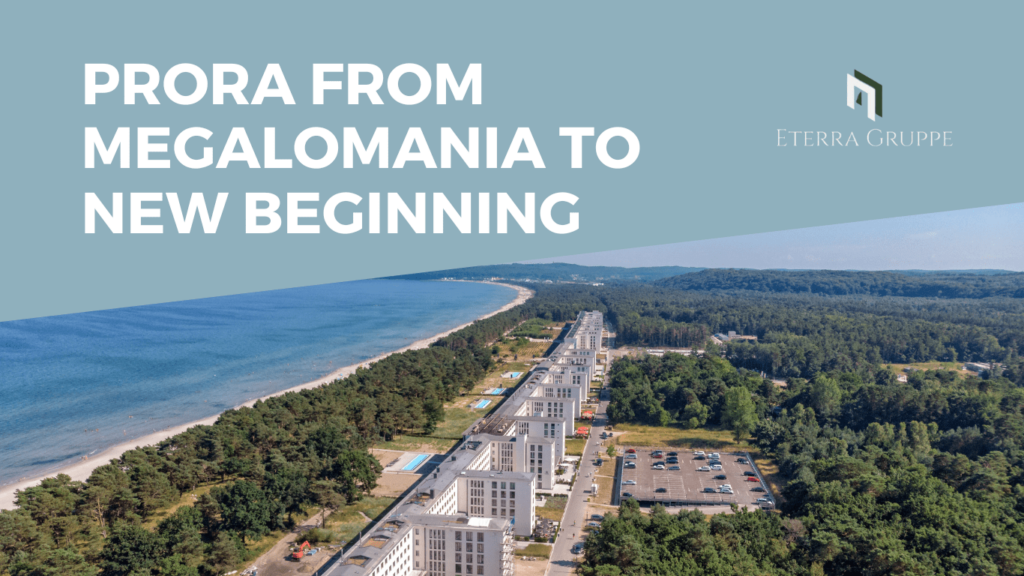The Colossus of Prora – Megalomania, Failure, and Rebirth – The Fascinating Saga of a German Symbol through the Eyes of Daniel Slenters, Entrepreneur from Magdeburg.
The „Colossus of Prora“ on the island of Rügen is a relic of German history that still fascinates and evokes contemplation to this day. Originally conceived as part of the „Strength Through Joy“ (KdF) program of the National Socialists in the 1930s, Prora was intended to be a seaside resort for 20,000 workers – a monumental undertaking that was never fully realized. Today, the complex stands as a memorial to history and, at the same time, as an example of transformation and new beginnings in Germany.
A Dramatic Birth – in the Mid-1930s
Originally, there was nothing but sand, sea, and pine forests on the site. In Rügen, a princely house had risen to power as the ruler of all fields and seas. The Lords of Putbus, whose influence left various marks on Rügen, had been ruling over the land for centuries. The family’s agricultural estate had originally been the source of income from their Putbus Castle. Essentially, the family owned the entire island of Rügen. The capital, Putbus, had been transformed into a beautiful white city with roses planted everywhere. The family cleverly realized that the property could be utilized in other ways. The motto was to move away from mundane agriculture and meager fishing in the Baltic Sea, and towards new business ventures. By the mid-1930s, the sleepy fishing village of Binz on the most beautiful coast of Rügen had already become a kind of fashionable seaside resort. The Lords of Putbus had attracted wealthy Berlin bathers. And there was this strip towards Sassnitz on the coast, where the Colossus of Prora now stands. Essentially, it was a sandy desert with pine trees. This area was of no interest for agriculture. Since the current Lord of Putbus was leaning towards the Nazis, there was a generous donation to the state to build a gigantic seaside resort. They sympathized with each other; the new and old lords in the 1930s. However, the local party leaders quickly became divided, due to their pettiness conflicting with the grandeur of the local prince Putbus. „… remember that, junior leader,“ is a saying that found its way into the court records. In short, the downfall of the House of Putbus as proud rulers over land and people is closely linked to the construction of the Prora seaside resort on the land that originally belonged to the family.
Construction of the Mega Project Started in 1936
Planning began in 1936 with the vision of creating a vacation spot for the German working class that would be unique in its size and amenities. Eight identical concrete blocks were built along a length of 4.5 kilometers, which included a festival hall, swimming pools, and even a pier for passenger ships. This architectural gigantism reflected the ideology and megalomania of the ruling powers at that time. The German construction industry was at the forefront. The construction of Prora was a major contract that everyone gladly accepted.
With the outbreak of World War II after 1939, work on Prora was abruptly halted. The partially completed structures were put to different uses during World War II: they served the Wehrmacht and later the Red Army. The donor of the land, Lord of Putbus, died while in the custody of the National Socialists in 1945. Later, the entire family was expropriated, the castle was destroyed, and the proud rulers of Putbus were finally expelled to West Germany.
Rügen is in the East – in the GDR
After the war, the German Democratic Republic (GDR) began using Prora for military purposes. 60 million East German marks were invested in converting the existing blocks into barracks. Until 1990, Prora served as a location for thousands of members of various military units of the National People’s Army (NVA). Watched by Western spies, as reports from the CIA can be found in the archives, a large military camp was established. The rooms somehow had to be used. No major renovation or continuation of construction took place. Many former soldiers or construction soldiers and foreign military personnel remember their time there with joy or negative feelings. It was a restricted area for the public. In the 1970s, rumors circulated of a submarine base and secret tunnels beneath the complex. The GDR government took advantage of the proximity to Mukran. A large port was built there. This military use had nothing to do with love for architecture or sentimental feelings. The military camp at Prora was a place of secrecy. The seaside resort of Binz, a few kilometers away, became a huge GDR holiday park. People now took vacations there. The buildings of the Colossus of Prora were only preserved as much as necessary.
1990 – the Great War Didn’t Happen, the GDR Imploded, the FRG was Without a Plan
After German reunification in 1990, the („victorious“) Bundeswehr ceased using Prora. The complex was placed under monument protection in 1994 and continued to deteriorate. The descendants of the generous donor from Putbus began a grotesque legal dispute with the German state and actually wanted to reclaim half of Rügen, with farmers and land. The 1990s can be forgotten, just remember this: those who fly too high will fall. In 1998, the highest German court definitively dismissed the lawsuit. Meanwhile, the building continued to decay. A brave group of volunteers opened a kind of private museum. Later, starting in 2010, Berlin investors got burned when they tried to buy parts of the properties from the Federal Republic of Germany, envisioning a huge luxury retreat. Companies went bankrupt, but eventually, they managed to transform and renovate the Colossus of Prora into apartments, hotels, a youth hostel, and so on. It became famous when a real estate agent advertised the luxury quarters with the legendary story that a sheikh from Arabia had also bought an apartment because he can ride bicycles so well on Rügen. While this was a bit of a stretch, it was also charming in a way. The apartments sold like hotcakes, to owner-occupiers, tax savers, and external renters alike. Today, life has returned to the Colossus, and construction and renovation work continue. Whether it is Nazi tourists, soldiers, or families enjoying the beach and the Baltic Sea, it doesn’t matter. The Colossus is famously located on one of the most beautiful beaches on the Baltic Sea. As always, location is key. And how do you get there? The area still benefits from its generous connection to the German Railways and its good accessibility by car.
Today, the history of Prora stands as a symbol of the horrors and wrong turns of German history in the 20th century. It is a reminder of the era of National Socialism, war, post-war times, and the era of the GDR. It is a story of courage, strength, and failure. In the 21st century, it becomes an example of how places and buildings that were originally built for ideological purposes can be transformed and integrated into modern society.
Author: Daniel Slenters, Entrepreneur
About the Eterra Group:
The Eterra Group is an innovative and future-oriented real estate company based in Magdeburg, dedicated to sustainable living. The company offers a wide range of services and works closely with its customers and investors to meet individual needs.
Company Headquarters:
ETERRA Gruppe GmbH
Halberstädter Straße 13
39112 Magdeburg
Branch Offices:
Kurfürstendamm 11, 10179 Berlin, Germany
Bartolome Buadas Mayol 6 BL. B 4 C – SES ILLETES 07184 Calvia (Illes Balears), Spain
Palma de Mallorca; CAS Catala
Contact:
ETERRA Gruppe GmbH
Halberstädter Straße 13
39112 Magdeburg
Tel: +49 (0) 391 6111 5868
Email: presse@eterra-gruppe.de
https://www.eterragruppe.com
CEOs: RA Matthias Claßen & Beate Jansen





